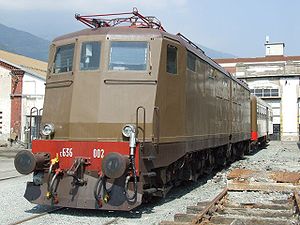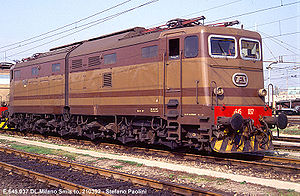
Murazze di Vado train disaster
Encyclopedia
The Murazze di Vado train disaster was a railway accident which occurred on April 15, 1978, near Murazze di Vado, an area in the town of Vado
, part of the Monzuno
comune
, Bologna
. A passenger train was derailed close to a ravine, and seconds later a second train crashed into it.
With 42 killed and 76 injured, it is the fourth highest death toll in the history of the Italian railways, after the Balvano
, Fiumarella
and Voghera
disasters. While the official count of the injured is 76, the actual number of injured is often said to be from 117 to more than 120.
 Passenger train "572 bis", pulled by two engines (FS Class E645.016 and FS Class E636
Passenger train "572 bis", pulled by two engines (FS Class E645.016 and FS Class E636
.282), was traveling along the Direttissima (Florence–Rome high-speed railway) line between Florence
and Bologna
when, shortly after noon, it was derailed by a small landslide that fell onto the rails. The railway track passed metres from a ravine along the A1 motorway, but the train fortunately stopped shortly before falling: up to that point, no major injuries had been caused by the accident.
 The "Rapido 813", nicknamed "Freccia della Laguna", was leaving Bolzano heading to Rome
The "Rapido 813", nicknamed "Freccia della Laguna", was leaving Bolzano heading to Rome
and was running on the opposite track: the train was made up of two FS Class ALe601 units, 051 and 067, along with FS Class Le480.010 and FS Class Le601.024 coaches. The Freccia della Laguna was on a rapid service, thus traveling at medium-high speed, when it hit the derailed train, still balanced on the side of the ravine.
The crash forced the four cars of Rapido 813 into the gorge: the two engines from 572 bis were lifted from their bogie
s, the bodies being crushed, falling to one side and coming to rest one above the other, with E645 on top.
Among the passengers were the Verona
soccer team who at the time were in the restaurant car, one of the less damaged cars, and so escaped the disaster unscathed.
CePIS was instrumental in creating the first unified emergency number in Italy, setting up the first centralized regional emergency management center, and joining the many hospitals and private ambulance crews under a single directorate.
The coordination of the rescue services was widely praised for their efficiency in the Murazze di Vado disaster. Coordination between police forces, crews and rescue vehicles allowed for speedy evacuation of the injured to Bologna's Ospedale Maggiore, unprecedented in the country and replicated a few years later in the Bologna Massacre of 1980.
CePIS later became the instigator of Italy's 118 unified emergency number created in the wake of 1990 FIFA World Cup
, phased out in 2011 in favor of the 112 European unified number.
.
Vado
Teeyon Winfree, or best known as Vado, born on March 13, 1985, is an American rapper from Harlem, New York City. Vado is of Jamaican, St.Vincent and African American descent.-Career:...
, part of the Monzuno
Monzuno
Monzuno is an Italian comune in the province of Bologna .The territory of the commune is loctaed on the western slope of the Savena valley, on the northern ridge of Monte Venere and on the left side of the Setta and Sambro streams....
comune
Comune
In Italy, the comune is the basic administrative division, and may be properly approximated in casual speech by the English word township or municipality.-Importance and function:...
, Bologna
Bologna
Bologna is the capital city of Emilia-Romagna, in the Po Valley of Northern Italy. The city lies between the Po River and the Apennine Mountains, more specifically, between the Reno River and the Savena River. Bologna is a lively and cosmopolitan Italian college city, with spectacular history,...
. A passenger train was derailed close to a ravine, and seconds later a second train crashed into it.
With 42 killed and 76 injured, it is the fourth highest death toll in the history of the Italian railways, after the Balvano
Balvano train disaster
In the Balvano train disaster of March 2/3, 1944, some 426 people illegally riding a steam-hauled freight train died of carbon monoxide poisoning when the train stalled on a steep gradient in the Armi tunnel. The accident occurred in southern Italy, near Balvano .-Circumstances:Naples suffered...
, Fiumarella
Fiumarella rail disaster
The Fiumarella rail disaster was one of the most serious incidents in the history of the Italian railways. It occurred at about 7.45 am on 23 December 1961, at the Fiumarella viaduct, near Catanzaro, in the region of Calabria, southern Italy.-History:...
and Voghera
Voghera train crash
The Voghera train crash is considered one of the most serious incidents in the history of the Italian railways. It happened at track three of Voghera railway station, on the night of 31 May 1962. Sixty-four people lost their lives, and 40 were seriously injured....
disasters. While the official count of the injured is 76, the actual number of injured is often said to be from 117 to more than 120.
Derailment and crash

FS class E636
The FS E636 is a class of Italian articulated electric locomotives. They were introduced in the course of the 1940s until the 1960s, and have been decommissioned in 2006. They have been one of the most numerous Italian locomotive group, and have been widely employed during their long career,...
.282), was traveling along the Direttissima (Florence–Rome high-speed railway) line between Florence
Florence
Florence is the capital city of the Italian region of Tuscany and of the province of Florence. It is the most populous city in Tuscany, with approximately 370,000 inhabitants, expanding to over 1.5 million in the metropolitan area....
and Bologna
Bologna
Bologna is the capital city of Emilia-Romagna, in the Po Valley of Northern Italy. The city lies between the Po River and the Apennine Mountains, more specifically, between the Reno River and the Savena River. Bologna is a lively and cosmopolitan Italian college city, with spectacular history,...
when, shortly after noon, it was derailed by a small landslide that fell onto the rails. The railway track passed metres from a ravine along the A1 motorway, but the train fortunately stopped shortly before falling: up to that point, no major injuries had been caused by the accident.

Rome
Rome is the capital of Italy and the country's largest and most populated city and comune, with over 2.7 million residents in . The city is located in the central-western portion of the Italian Peninsula, on the Tiber River within the Lazio region of Italy.Rome's history spans two and a half...
and was running on the opposite track: the train was made up of two FS Class ALe601 units, 051 and 067, along with FS Class Le480.010 and FS Class Le601.024 coaches. The Freccia della Laguna was on a rapid service, thus traveling at medium-high speed, when it hit the derailed train, still balanced on the side of the ravine.
The crash forced the four cars of Rapido 813 into the gorge: the two engines from 572 bis were lifted from their bogie
Bogie
A bogie is a wheeled wagon or trolley. In mechanics terms, a bogie is a chassis or framework carrying wheels, attached to a vehicle. It can be fixed in place, as on a cargo truck, mounted on a swivel, as on a railway carriage/car or locomotive, or sprung as in the suspension of a caterpillar...
s, the bodies being crushed, falling to one side and coming to rest one above the other, with E645 on top.
Among the passengers were the Verona
Verona
Verona ; German Bern, Dietrichsbern or Welschbern) is a city in the Veneto, northern Italy, with approx. 265,000 inhabitants and one of the seven chef-lieus of the region. It is the second largest city municipality in the region and the third of North-Eastern Italy. The metropolitan area of Verona...
soccer team who at the time were in the restaurant car, one of the less damaged cars, and so escaped the disaster unscathed.
First response coordination
The Murazze di Vado disaster was the first large scale rescue operation managed by CePIS, a public organization founded after the 1974 Italicus Express bombing to provide better first aid in emergencies and improve coordination of local response services on a regional scale.CePIS was instrumental in creating the first unified emergency number in Italy, setting up the first centralized regional emergency management center, and joining the many hospitals and private ambulance crews under a single directorate.
The coordination of the rescue services was widely praised for their efficiency in the Murazze di Vado disaster. Coordination between police forces, crews and rescue vehicles allowed for speedy evacuation of the injured to Bologna's Ospedale Maggiore, unprecedented in the country and replicated a few years later in the Bologna Massacre of 1980.
CePIS later became the instigator of Italy's 118 unified emergency number created in the wake of 1990 FIFA World Cup
1990 FIFA World Cup
The 1990 FIFA World Cup was the 14th FIFA World Cup, the quadrennial international football world championship tournament. It was held from 8 June to 8 July 1990 in Italy, the second country to host the event twice. Teams representing 116 national football associations from all six populated...
, phased out in 2011 in favor of the 112 European unified number.
Aftermath
E645.016 was demolished after the disaster, along with the full ALe601-Le480 trainset. E636.282 was rebuilt and put back into service. After the disaster the train was renamed the Marco PoloMarco Polo
Marco Polo was a Venetian merchant traveler from the Venetian Republic whose travels are recorded in Il Milione, a book which did much to introduce Europeans to Central Asia and China. He learned about trading whilst his father and uncle, Niccolò and Maffeo, travelled through Asia and apparently...
.

